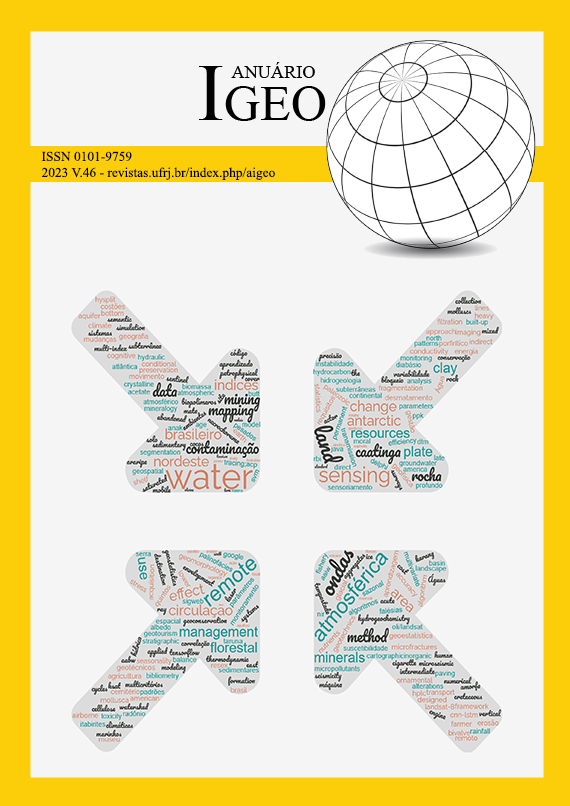Sensitivity Analysis of SWAT Model in a Tropical Watershed, East Java
DOI:
https://doi.org/10.11137/1982-3908_2023_46_48173Keywords:
Sufi, SWAT-CUP, BrantasAbstract
Brantas watershed has approximately 14,103 km2 and play an essential role in supplying water for about 30% of the East Java population. Management of water resources in this watershed has become a challenging issue. Conformity of modeling processes and result to mimic the existing hydrological processes is still in question. This study aims to analyze the sensitive parameters of the Soil & Water Assessment Tool (SWAT) model on the watershed. Hydrological processes are observed both monthly and annually. Sensitivity analysis using the SWAT-CUP tool show 18 sensitive parameters. 9 parameters have more than a 50% sensitivity level. 4 are correlated to the soil layer’s runoff generation and water movement. Then, 8 parameters correlated to baseflow calculation. Simulation results illustrate the strong effect of climate change (especially rainfall) on water yield and sedimentation.
Downloads
References
Abbaspour, K. 2015, 'SWAT-CUP Calibration and uncertainty programs', User Manual, pp. 1596-602, DOI:10.1007/s00402-009-1032-4.
Arnold, J.G., Moriasi, D.N., Gassman, P.W., Abbaspour, K.C., White, M.J., Srinivassan, R., Santhi, C., Harmel, R.D., van Griensven, A., Van Liew, M.W., Kannan, N. & Jha, M.K. 2012, 'Swat: model use, calibration, and validation', American Society of Agricultural and Biological Engineers, vol. 55, no. 4, pp. 1491-508.
Balitbang Pertanian 2014, Peta tanah dengan skala 1:50.000, Indonesian Agency for Agricultural Research and Development, viewed 12 January 2019, <http://balittanah.litbang.pertanian.go.id/ind/>.
BIG ‒ Badan Informasi Geospasial 2018, Seamless Digital Elevation Model (DEM) dan Batimetri Nasional, Badan Informasi Geospatial, viewed 12 January 2019, <http://tides.big.go.id/DEMNAS/>.
BPS ‒ Badan Pusat Statistik 2014, Proyeksi Penduduk Jawa Timur 2010 – 2020, Surabaya, viewed 12 January 2019, <https://jatim.bps.go.id>.
Brighenti, T.M., Bonumá, N.B., Grison, F., Mota, A.A., Kobiyama, M. & Chaffe, P.L.B. 2019, 'Two calibration methods for modeling streamflow and suspended sediment with the swat model', Ecological Engineering, vol. 127, pp. 103-13, DOI:10.1016/j.ecoleng.2018.11.007.
Erlina, E. 2018, 'Analisis Banjir Dan Sedimentasi Wilayah Sungai Brantas (Tinjaun Terhadap Metode Pengendalian)', Jurnal Teknik Sipil, vol. XIII, no. 1, pp. 1-14, DOI:10.47200/jts.v13i1.835.
JICA ‒ Japan International Cooperation Agency 2019, The Republic of Indonesia, the project for assessing and integrating climate change impacts into the water resources management plans for Brantas and Musi river basins: water resources management plan: final report, vol. II, Main Report, Japan, viewed 12 January 2019, <https://openjicareport.jica.go.jp/619/619/619_108_12353090.html>.
Joseph, N., Preetha, P.P. & Narasimhan, B. 2021, 'Assessment of environmental flow requirements using a coupled surface water-groundwater model and a flow health tool: A case study of Son river in the Ganga basin', Ecological Indicators, vol. 121, 107110, DOI: 10.1016/j.ecolind.2020.107110.
Kementerian, P.U.P.R. 2010, Pengelolaan sumber daya air wilayah sungai bengawan solo, Menteneri Pekeraan Umum Republik Indonesia, Jakarta.
Krysanova, V. & Arnold, J.G. 2008, 'Advances in ecohydrological modeling with SWAT-a review', Hydrological Sciences Journal, vol. 53, no. 5, pp. 939-47, DOI:10.1623/hysj.53.5.939.
Lamichhane, S. & Shakya, N.M. 2019, 'Integrated assessment of climate change and land use change impacts on hydrology in the Kathmandu Valley Watershed, Central Nepal', Water, vol. 11, no. 10, 2059, DOI: 10.3390/w11102059.
Liu, Z., Herman, J.D., Huang, G., Kadir, T. & Dahlke, H.E. 2021, 'Identifying climate change impacts on surface water supply in the southern Central Valley, California', Science of the Total Environment, vol. 759, 143429, DOI:10.1016/j.scitotenv.2020.143429.
Mireille, N.M., Mwangi, H.M., Mwangi, J.K. & Gathenya, J.M. 2019, 'Analysis of land use change and its impact on the hydrology of kakia and esamburmbur sub-watersheds of Narok County, Kenya', Hydrology, vol. 6, no. 4, 86, DOI:10.3390/hydrology6040086.
Moreira, L.L., Schwamback, D. & Rigo, D. 2018, 'Sensitivity analysis of the Soil and Water Assessment Tools (SWAT) model in streamflow modeling in a rural river basin', Revista Ambiente e Agua, vol. 13, no. 6, e2221, DOI:10.4136/ambi-agua.2221.
Moriasi, D.N., Arnold, J.G., Van Liew, M.W., Bingner, R.L., Harmel, R.D. & Veith, T.L. 2007, 'Model evaluation guidelines for systematic quantification of accuracy in watershed simulations', American Society of Agricultural and Biological Engineers, vol. 50, no. 3, pp. 885-900, DOI:10.13031/2013.23153.
Rani, S. & Sreekesh, S. 2021, 'Flow regime changes under future climate and land cover scenarios in the Upper Beas basin of Himalaya using SWAT model', International Journal of Environmental Studies, vol. 78, no. 3, pp. 382-97, DOI:10.1080/00207233.2020.1811574.
Spruce, J., Bolten, J., Srinivasan, R. & Lakshmi, V. 2018, 'Developing land use land cover maps for the lower mekong basin to aid hydrologic modeling and basin planning', Remote Sensing, vol. 10, no. 12, 1910, DOI:10.3390/rs10121910.
Downloads
Published
How to Cite
Issue
Section
License
This journal is licensed under a Creative Commons — Attribution 4.0 International — CC BY 4.0, which permits use, distribution and reproduction in any medium, provided the original work is properly cited.















